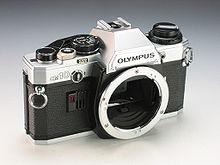Olympus OM-10
The Olympus OM-10 is a small picture - SLR (35 mm film), manual focus on the lens. It is the first amateur camera in the Olympus OM series.
Technical specifications
- Production OM-10: 1978 to 1987 by Olympus Optical Co., Japan
- Dimensions: 135 × 84 × 50 mm
- Weight: (housing alone) 450 grams
- Viewfinder: Pentaprism viewfinder with 93% viewing area; Permanently installed focusing screen with cross-sectional image indicator and microprismatic ring
- Exposure times: 1 - 1/1000 sec. And B.
- Type of closure: Cloth focal plane shutter with time control from approx. 1 to 1/1000 sec, running horizontally. In contrast to the OM-1 and OM-2, there is no mirror attenuation .
- Exposure metering: The camera only has an aperture priority function . The exposure measurement on the Olympus OM-10 is done through the lens ( TTL ); with the shutter open . The light reflected by the secondary mirror, the reference pattern and the film is measured (“off the film”, OTF; also called “ autodynamic ” control).
- Exposure compensation +/- 2 f-stops in 1/3 steps.
- Flash: built-in flash shoe above the prism ; Synchronization time 1/60 sec., No flash control from the camera. Readiness indicator built into the viewfinder in the upper left corner of the viewfinder.
- Self-timer: electronic, 12 seconds forward, with acoustic signal.
- Film transport: manual or with connected winder (2.5 fps), the Motor Drive cannot be used in contrast to the other Olympus cameras, film rewinding is manual
- Power supply: 2 silver oxide button cells ( SR44 )
particularities
The OM-10 was designed for pure amateur use. Therefore, the designers made some simplifications. The ground glass cannot be changed, the back wall cannot be exchanged, only the winder can be used and the camera can only time automatic. In order to still be able to influence the times, the so-called "manual adapter" could also be purchased. This attachment, which is plugged into a socket to the left of the bayonet, enables the photographer to carry out tracking measurements. In contrast to the OM-1 and-2, which have a needle display in the viewfinder, Olympus used light-emitting diodes for the first time with the OM-10. In order to save electricity, the measuring system of the OM-10 switches itself off. To wake it up from standby again, the ring around the shutter release must be tapped. The camera is relatively loud, which is due to the lack of a mirror damper. The mirror cannot be locked either. Only at a second glance does a plastic plate with a black and white pattern appear diagonally under the shutter release, on the front of the camera above the rewind release. It is not a control element, but a pure design element. It is intended to symbolize the presence of the autodynamic measurement control and shows, albeit somewhat simplified, the measurement pattern of the first shutter curtain. In the US, the OM-10 was known as the OM-10 FC. Except for the different labeling, there is no difference to the camera delivered in Europe.
Olympus OM-10 QD
Since the back wall cannot be removed, Olympus also supplied a variant with a data back wall in addition to the normal version, which was called OM-10 QD (quartz data). This camera was only delivered in black.
Web links
literature
- User manual in English: http://www.vieilalbum.com/documents_fichiers/Manuel%20Olympus%20OM-10.pdf
- Franz Pangerl: Everything about the OM10 and OM10 Quartz Data . Olympus Optical Co., Hamburg, 2nd extended edition. 1981.

